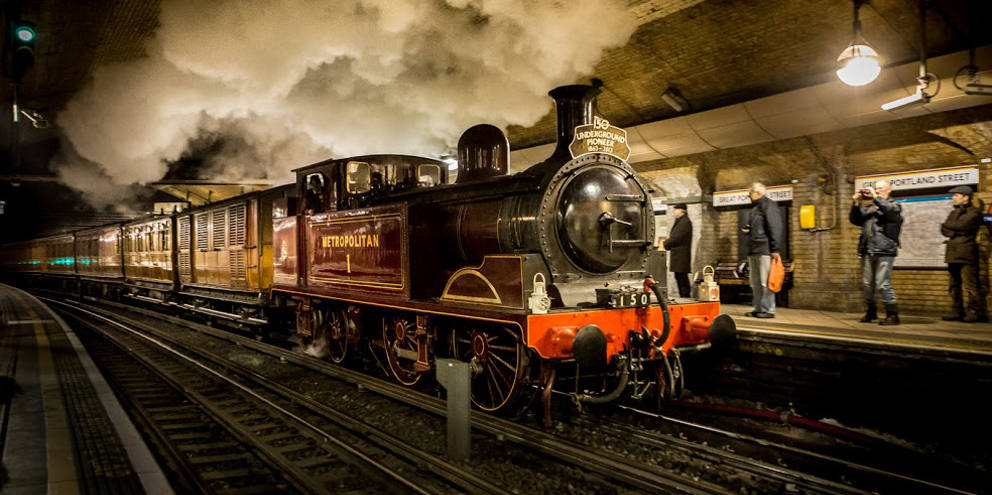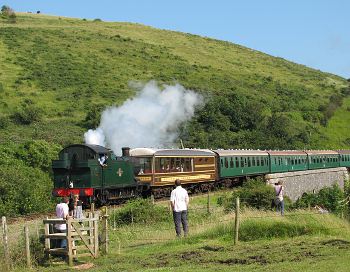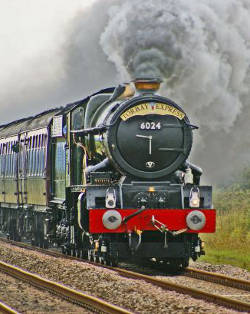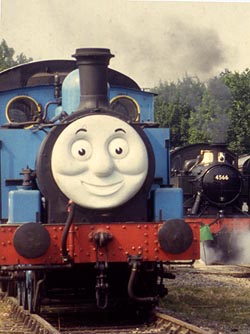

Britain's
steam heritage railways
Preserved railways, trains and other events
About-Britain.com
- a thematic guide to Britain
- Site index
- Essential
information
- Accidents and emergencies
- Pounds and pennies
- Hotel search
- Budget tourism - Britain on the cheap
- Online shopping from the UK
- Driving in Britain
- Low-cost car-hire
- Travel by train in Britain
- Visitor accommodation
- Hotels in London
- Britain's main attractions
- Food and eating in Britain
- Christmas in Britain
- English pubs
- Places
to visit
- Britain's main attractions
- Interactive tourist map
- Visiting London
- London for free
- Getting round in London
- Shopping in London
- More great English cities
- Oxford and Cambridge
- Tourism by region
- Discover southeast England
- Discover central southern England
- The West of England - Gloucestershire to Dorset
- The Westcountry - Devon and Cornwall
- Sites & heritage in the East of England
- About Scotland
- Attractions by theme
- Issues & institutions
The
heritage of steam : preserved railways, trains and other events
| On this page | Nostalgia for steam | The railway heritage |
| Heritage lines | Best railway museums |
Since
the demise of steam trains on Britain's railways, thousands of
enthusiasts and volunteers have been
working hard to ensure the survival of this great British invention, on
heritage railways and other special events around the country.
 Tornado
- a brand new steam locomotive built by volunteers
Tornado
- a brand new steam locomotive built by volunteersAnd it was not just any locomotive! The " Tornado " is a massive mainline express engine, an A1 class "Pacific", built from the original plans of A.H.Peppercorn , who was chief engineer of the London & North Eastern Railway after the second World War. This class of locomotive was built to haul the heaviest of mainline trains between London and Scotland, a distance of over 600 km or 400 miles. In February 2009, the Tornado, brand new, was the first steam locomotive in the 21st century to pull an express train from the north of England to Kings Cross Station in London - at speeds up to 70 mph or 120 km / h . Since then, it has clocked up a speed of over 100 mph (160 km/h) on a specially authorised test run.
Now, this locomotive has joined the small family of steam locomotives that are authorised to haul special trains, which run almost every weekend of the year, on the national rail network. (Schedule of special trains).
Britain's steam heritage
 The
Swanage Railway, in Dorset
The
Swanage Railway, in DorsetHotels
in Britain at the best rates
from Booking.com
Britain has more than a hundred lines or museums
with steam
trains. "Heritage lines" and regular heritage trains also operate on a
few
sections of the national rail network. All in all, visitors have a vast
choice of steam-hauled trains, running over
distances ranging from a couple of miles to over 40 miles (almost 70
km), and double that for those who do the round trip.from Booking.com
- A selection of budget hotels in Britain
- Large choice of two-star hotels in Britain
- Large choice of three-star hotels in Britain
- Large choice of luxury hotels in Britain
Most of these lines offer a steam-hauled service every day in July and August, every weekend in the spring and fall; and of course, many of these lines are among the most visited tourist sites in their region . All these lines operate wholly or largely through the efforts and dedication of hundreds of fans and enthusiasts, who volunteer every weekend, to help provide an authentic visitor experience and a trip into the past.
In addition to the many heritage railway routes, Britain also has a numpber of major railway museums, including the National Railway Museum in York, the world's biggest railway museum.
You will find below a selection of some of the best heritage steam railways in Britain, the ones that offer the longest or most picturesque trips, or those that are most interesting in terms of the material used.
After that, you will find a list of top railway museums in England.
Top ten lines: a selection of the best heritage lines with steam traction.
-
The Great Central Railway, Loughborough , Leicestershire
Central England
13 km of track between Loughborough and Leicester , including 9 km double track, the only stretch of double track on a preserved line. A dozen steam locomotives, large and small. Unlike other heritage lines, trains are allowed to reach a speed of 90 km / h on this line, thanks to its double track. -
The Severn Valley Railway, 26 km from Bridgnorth to Kidderminster
Shropshire and Worcestershire, west of Birmingham.
The most famous lines , because of its bucolic route in the valley of the River Severn . Everything is renovated old, and the line is frequentloy used for films. -
The Bluebell Line , Sheffield Park, Sussex.
A few miles south of London
The oldest of Britain's standard-gauge heritage lines, The Bluebell was saved for posterity by amateurs in 1960 . This is the most popular tourist attraction in Sussex . All trains on this 14 km / 9 mile line are steam locomotives with a variety of engines including a Southern Railway Pacific and a GWR " Dukedog ", a very old locomotive part of which dates back to 1906 ! -
The West Somerset Railway. Bishop's Lydeard to Minehead .
Near Taunton, southwest England
Over 30 km long, running partly beside the sea, the WSR is the longest privately run heritage railway in Britain. It provides visitors with the real feel that they are going somewhere, a with a journey time of an hour and a quarter in each direction. The workshop at Minehead has a number of interesting steam locomotives. -
The North Yorkshire Moors Railway. Pickering to Grosmont
North Yorkshiren in the northeast of England
In terms of length, the second longest England Heritage line. Trains now continue to Whitby, using a few kilometers of the national network. this line has a great collection of steam locomotives , including a famous Gresley A4 Pacific, whose sister "Mallard" holds the world speed record for a steam locomotive ( 126 mph / 202.8 km / h ) . -
The Keighley & Worth Valley Railway.
West Yorkshire, Near Bradford.
8 km scenic railway in the heart of the Pennine Moors . It passes by the small town of Haworth, which was once home to the Brontë sisters ( Wuthering Heights and other famous novels) . The line has a dozen steam locomotives. It was used for the filming of one of the most famous railway fiction films, the Railway Children. -
the Swanage Railway
Near Poole, Dorset
A few miles of track in a beautiful rural area of Dorset. the line runs past the impressive ruins of the mediaeval Corfe Castle, and on to the small seaside resort of Swanage. -
Gloucestershire and Warwickshire Railway
Between Cheltenham and Stratford on Avon
Twelve and a half miles of track between Cheltenham Racecourse station, and Laverton, near Broadway. Once part of the Great Western Railway's main line from Cheltenham to Birmingham, the new GWR is a single track railway. It runs through beautiful countryside on the edge of the Cotswolds. Main access to trains is at Toddington, in the middle of the line.

A great pacific locomotive on the North Yorkshire Moors Railway
-
The West Highland Line : From Fort William to Mallaig , Scotland.
Scottish Highlands - southwest of Loch Ness
While the trains are privately run, the line they use is part of the national rail network. But every day in summer , a private company operates a daily service on this spectacular steam line which is 42 miles or 67 km long . Apart from those used for the trip, there are no other steam locomotives on this line . The Glenfinnan Viaduct (pictured ) was the first bridge in the world to be built in concrete , it appears in the first Harry Potter movie . -
The Ffestiniog Railway . North Wales
North Wales - from the coast to Snowdonia See on map
the most famous of several narrow gauge lines in the Welsh mountains.
The 0.6 metre gauge Ffestiniog runs for 21.5 km from the port of Porthmadog, on the west coast Welsh to Blaenau Ffestiniog, once an important slate-quarrying town in the mountains of Snowdonia . The line uses historic stock (locomotives and wagons) carefully preserved and renovated... or built from scratch.
The Ffestiniog is directly linked to the "new" "Welsh Highland Line" - a fantastic project which has seen the total rebuilding of an old narrow-gauge line, which had previously been abandoned for half a century. The WHL runs for more than 40 km, between Caernarfon and Porthmadog - through the Snowdonia National Park . All in all, the west coast of Wales has four narrow gauge railways, with very old steam locomotives. The other two are the Talyllyn and the Vale of Rheidol railway. See on map Marker 1 Marker 2
Best railway museums
-
The National Railway Museum,
York ( Northeast England )
Established in 1975 , the museum has brought together under a single roof the various museums that existed before then, some of which had begun to preserve steam locomotives as far back as the mid-19th century. In other words , this is a unparalleled museum , which tells the story of railways in Great Britain and of steam locomotives from the very beginning. This is also the largest railway museum in the world, and has already attracted over 20 million visitors . -
Didcot Railway Centre
Near Oxford, 50 miles west of London.
The world 's largest collection of steam locomotives formerly belonging to the same company - in this case the Great Western Railway. Twenty-four steam locomotives, including examples in working order, of the most powerful locos of the historic GWR, the " kings " and " castles ". Steam trains are operated on special "steam days". -
Tysley Locomotive Works
Birmingham. West Midlands
Another site with more than twenty steam locomotives, some of which are used for hauling steam specials on the national network. -
The Midland Railway, Butterley , Derbyshire.
Central northern England
A collection of steam locomotives, including two large "Pacifics" of the former LNWR. In addition to steam locomotives, the site also has displays of industrial and agricultural machinery, as well as a miniature railway
Photo above: an
exceptional event; steam returned briefly to the London
Underground, for a few nights in 2013, to commemorate the 150th
anniversary of the opening of the
world's first underground railway.
Photo © JR - About-Britain.com.
Photo © JR - About-Britain.com.
From
their earliest beginnings in the late 18th century, and in particular
since the start of the "railway age" around 1830, railways have been
aprt of the landscape in Britain. Today, the steam train
experience, with its steam and smoke and unforgettable sounds, survives
on about a hundred heritage railways up and down the country
– and also
with the many steam-hauled special trains that now run again on the
nation's main rail network.

A special steam train
running at speed on the mainline network.

A children's favourite
- Thomas the tank engine, on the Gloucestershire and Warwickshire
railway
| About-Britain
site guide |
| Essential
travel
& tourism info |
| Pounds
& pence - Britain's currency |
| Driving in
Britain |
| Train travel in Britain |
| Britain
on a limited budget |
| Hotels and accommodation |
| Food and eating in Britain |
| English pubs |
| Cities
and countryside |
| Visiting London |
| London for free |
| Getting round in London |
| Other big cities in England |
| Oxford and Cambridge |
| England's coasts and seasides |
| Major
attractions
by theme |
| Britain's main attractions |
| Mediaeval cathedrals in England |
| Best zoos and wildlife parks |
| Living history open air museums |

The Ffestiniog, one of
the great little railways of Wales
Copyright
: Website photos and texts ©
About-Britain.com
except where otherwise indicated.
Creative commons photo credits:
Ffestiniog railway: : Rob Phillips.
"Tornado" from Freephotouk.
North Yorks Moors railway by Cooldudeandy01.
Website contact
Creative commons photo credits:
Ffestiniog railway: : Rob Phillips.
"Tornado" from Freephotouk.
North Yorks Moors railway by Cooldudeandy01.
Website contact